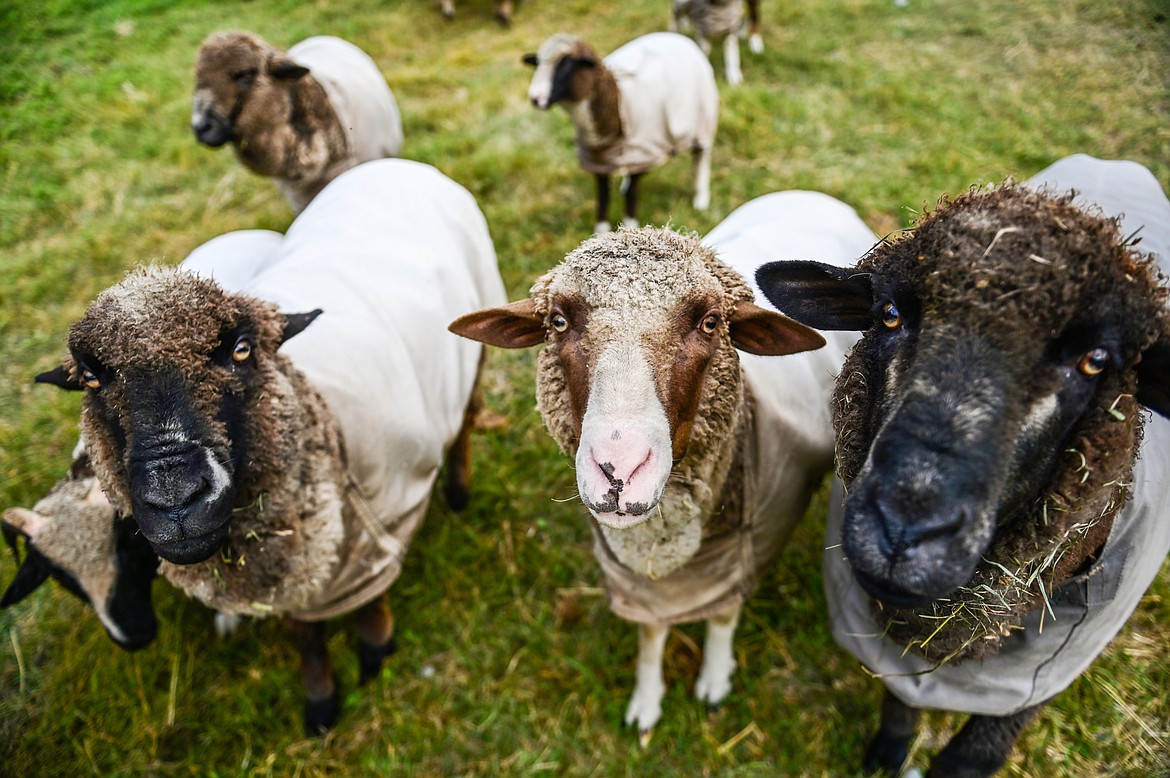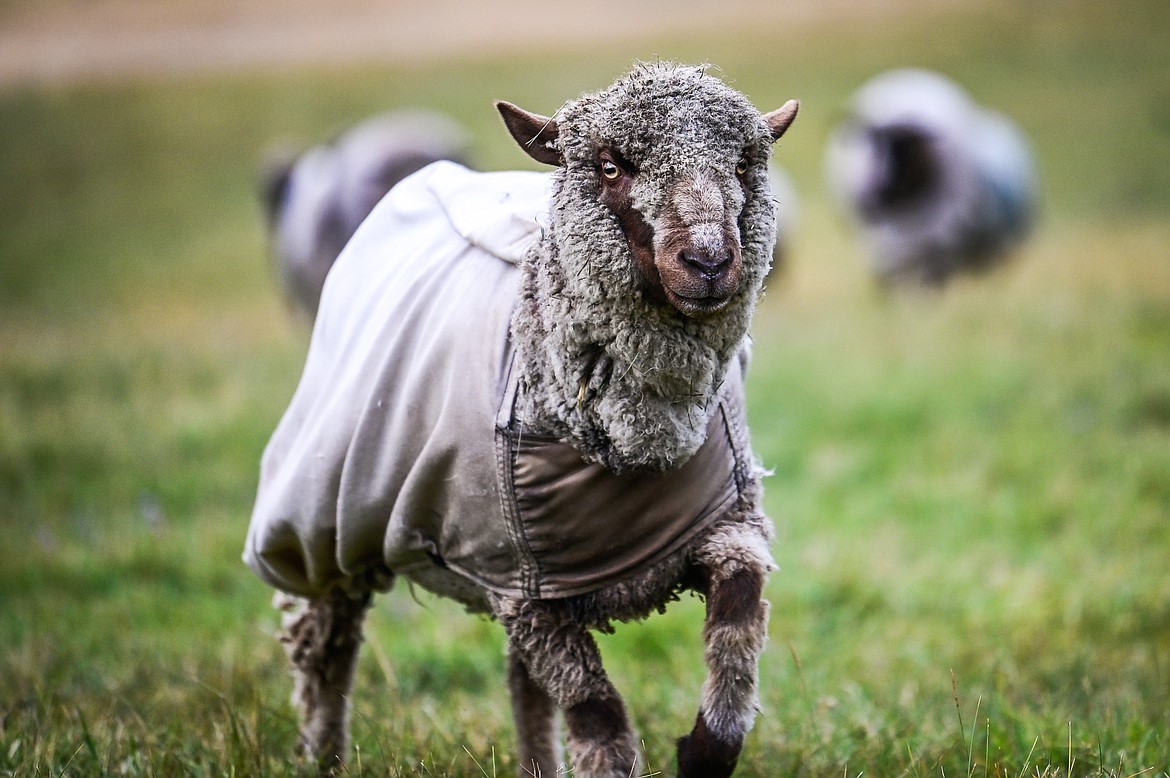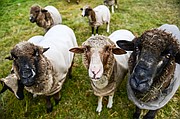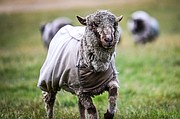Black sheep — and proud of it
John Steitz likely has never met a black sheep he couldn’t love.
Or a brown, gray or piebald one, for that matter.
“I let the big boys deal with the white ones,” he says, tromping uphill atop a combination of hay, gravel and droppings toward his flock of multi-colored ewes. “There is such a need for the colored wool.”
To get to them, John, joined by his wife, Carol Steitz, has to shoo away a small rafter of wild turkeys lounging on the gate. Breeding season is over and rams waiting just beyond the fence line pleat plaintively — some a little more than plaintively — as the gate swings shut behind them.
The overcast sky is spitting rain again on a damp September afternoon and the Steitz’s Merino sheep are bedecked in coverings to keep the wool clean. The garments represent an expenditure of capital, but well worth the money, John says.
His prospective buyers, many of them artists, look for clean wool to work with. It was just one lesson the pair learned as they entered the collegial and cooperative world of colored wool and fiber.
“The coats made a huge difference,” John says. “It’s an investment.”
He laughs as the ewes circle him and Carol, seemingly oblivious to the weather but eager to snag treats from their owners.
“The sheep don’t care.”
RAISED ON a farm, John was well versed in the struggle of making a go of it commercially.
“I lost my shirt doing it; it’s not pretty,” he says.
Putting aside farm life, he bounced around, eventually becoming a highway engineer in New York. Carol is a geologist by training. Then the Great Recession hit.
It was an opportunity to reassess. John recalls reading his grandmother’s notes from the Great Depression. The family pulled through because of the farm.
So they moved west. The two secured a plot on Farm to Market Road, but it was pretty beat up. He knew sheep could help improve the land from his experience working on the farm. At the same time, he had an idea for producing colored wool.
John bought his first ewe from a flock on Foys Lake Road. Its original owner tossed in a wealth of information about the animals free of charge. It served as John and Carol’s welcome to the interconnected and supportive wool community in the Flathead Valley.
Eventually, the pair bought 15 acres on an incline overlooking Batavia, a property now known as Steitzhof. It’s a short drive from U.S. 2 and just minutes from Kalispell, but after a couple of turns and a short trek down a dirt road, it’s a completely different world.
“I’m definitely out of the office,” John says. “My office is walking around in a field — I love it.”
Beyond the daily walks with the sheep — an opportunity to get a sense of what work they need as well as a pleasant way to wake up with a cup of coffee, John says — he collects and analyzes reams of data. He takes great care in which animals breed and carefully selects new rams to bring into the flock. Climate, he says, plays a role in the quality of wool. As does diet.
For specialized work, he sends samples to the Montana Wool Lab at Montana State University. Their analysis often helps him in the buying process, he says.
Carol, meanwhile, is eager to dive into a discussion of regenerative farming and the carbon cycle, which she wrote a dissertation on, specifically the role of soils. The sun shines and the grass grows. The sheep eat the grass, turning it into wool. Meanwhile, their excrement becomes compost for the soil.
The wool then goes into an array of products, mostly clothing. Some of it heads to Belgrade, where The Wool Mill turns it into yarn using a waste-free process that relies on solar power.
“Wool is 50% carbon,” she says. “And an artist uses it.”
Their land has improved tremendously over the years, John says while discussing his process for moving the sheep from plot to plot.
“Meanwhile, we’re building wool at the same time,” he says. “They go hand-in-hand. They take care of each other.”
EACH OF the sheep in the Steitz’s flock has a name. They also have their own personalities. Both John and Carol are quick to note that it doesn’t take long for the animals to feel like pets.
“It’s a hobby, it’s a love, but you can’t be shelling out all the time,” John says, recalling his approach to finding an end destination for the flock’s output.
Carol touts his use of social media to find clients. Attending events like the Black Sheep Gathering in Albany, Oregon, also got the word out about the Steitz’s Merinos. In 2019 — and after a lot of learning — the two brought home the Black Sheep Cup.
The award is given out for the five most valuable handspinning fleeces from a single producer. It was the first time the cup came to Montana, and it earned the pair a note of congratulations from then-Gov. Steve Bullock.
The trophy remains proudly displayed in the Steitz’s living room. After the multiyear hiatus, the Black Sheep Gathering returned this year and the Steitz’s won the cup again. Moondance, one of the pair’s ewes, also won the Wayne Thompson Memorial for the Best Natural Colored Fleece and earned Champion Colored Fleece in the event’s Fleece Show.
“We’re not in it to win awards,” John says, beaming. “But here we are with the Stanley Cup.”
Beyond running a successful small business, winning awards and caring for his flock, John wants to get the word out about his new life. It’s something he views as attainable and sustainable, even for young people worried at the growing cost of property. You don’t need much land, he says, and you can start out renting or leasing. You won’t get rich, he warns, but you will make enough to expand and improve your land.
“My biggest thing is that I want to [tell] other people who have this thought … there are ways to do this in a small farm,” he says. “If you want to ask me about it, come find me.”
There’s a community behind their operation, John and Carol say. On shearing day, a veritable army of friends and family show up to assist. The Steitz’s band together each year with the owners of other flocks in the valley to bring in a pro from Iowa for the occasion.
Those same owners exchange medicines and feed at times. John loans out rams for breeding purposes. When the pair get a customer they can’t help, they’re happy to send them to a friend in the community that might have what the prospective client needs.
“Overall, it gives you a sense of community,” Carol says. “Farming is a community. … If one succeeds, all succeed.”
News Editor Derrick Perkins can be reached at 758-4430 or dperkins@dailyinterlake.com.






